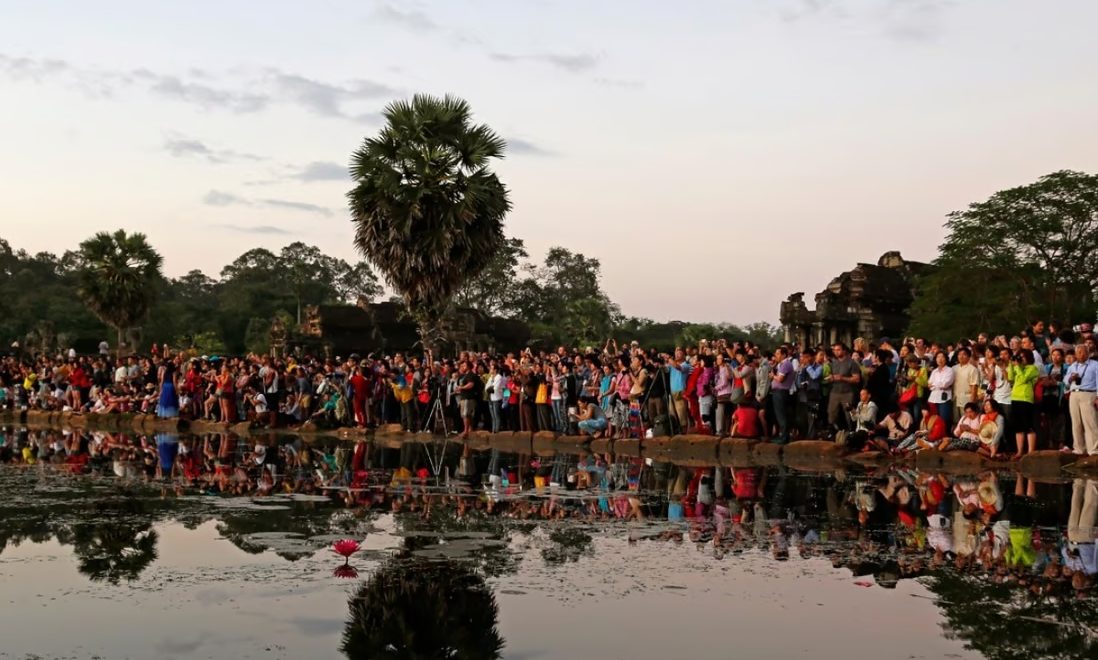Tour operators’ tips to avoid the crowds at Asia’s most popular tourist destinations

The dark cloaks the crowds that swarm through the gates of Cambodia’s Angkor Wat to catch a glimpse of the sun peeking from behind the ancient temple’s spires. Like an army of ants, they charge towards the lotus lake at the front of the site – a prime spot to capture the quintessential sunrise shot.
Or it was.
Today the crowd of thousands who flock there have transformed this once soothing, spiritual experience into an elbow fight for a prime sightseeing spot and at times a jostle for even a glimpse of the view.
The global tourist invasion: what travellers can do to alleviate it
“It’s crazy there at sunrise now,” says Sareth Houl, who has worked as a tour guide at Angkor for seven years. “It’s not enjoyable any more, there are too many people.”
As Cambodia’s top tourist draw, Angkor has become overrun with tourists in recent years. According to the Ministry of Tourism, in the mid-1990s about 7,500 visitors explored the site annually. Last year, this figure hit almost 2.5 million.
“Angkor Wat Archaeological Park is huge,” says Hou. “Of course, Angkor Wat is the most impressive, but the crowds spoil what makes it special and there are many quieter, beautiful places to enjoy sunrise.”
The typical tourist itinerary includes sunrise at Angkor Wat before heading to Bayon and Ta Prohm. To dodge the crowds, Hou suggests trading in Angkor for Srah Srang, a 900-year-old lake that offers breathtaking reflections of the sunrise with virtually no people around.
Its proximity to Ta Prohm – the root-riddled temple made famous by Lara Croft: Tomb Raider featuring Angelina Jolie – means visitors can explore the temple while the masses are still swamping Bayon.
“You get the temple virtually to yourself,” says Hou. “Something that seems impossible when sticking to the same route as everyone else.”
Bertie Lawson, managing director of Sampan Travel in Myanmar, agrees that spreading the flow of tourists is becoming increasingly important. “Too crowded tourists sites lead to a bad experience for the tourist, and for local people,” he says, highlighting Venice and Barcelona as extreme examples.
While mass tourism is a long way off reaching Myanmar, which welcomed 3.44 million visitors in 2017, Lawson says the majority tend to flock to the same few spots, creating crowded hubs. Instead, he suggests seeking out the many secluded spots around the country.
Overtourism forces closure of Thai beach from Leonardo DiCaprio film
And what about the main attraction – the ancient city of Bagan? “The most enjoyable thing is getting lost among the temples,” says Lawson. “Everyone must find their own secluded spot. With the site home to more than 2,200 temples, welcoming about 280,000 visitors, this shouldn’t be difficult.
“The greatest things about travelling in Myanmar is how ‘untouristy’ much of it is, and how welcoming the local people are,” adds Lawson. “If this was lost, it would be a sad day for Myanmar tourism.”
In Vietnam’s world-renowned Halong Bay, cruise boats clog up many of the Unesco site’s waterways, triggering environmental concerns. This has caused some tour operators to hunt out isolated spots and revamp itineraries accordingly.
“We spend a lot of time creating unique itineraries that lead our guests to less visited areas within the bay,” says Armand Cheveux, director of marketing at Bhaya Group, which runs a series of cruises.
Visit Kep in Cambodia, the laid-back beach retreat making a comeback
It recently launched a tour that takes in Halong Bay’s hidden spots, including lesser-visited pearl farms, caves, lakes and tunnels that cut through the limestone karst and are perfect for kayaking in without colliding with another boat.
Alternative tours like these help to reduce congestion and pollution in the busier areas of the bay. The cruise company is also working on several environmental initiatives, including reducing plastic consumption on board and energy saving measures, as well as various local environmental educational programmes and litter clean-ups of the bay.
Mass tourism has taken its toll on parts of Thailand. In June, tourists were banned from visiting Maya Bay in the Andaman Sea – made famous by The Beach, featuring Leonardo DiCaprio. It will reopen on September 30 after studies into environmental damage and sustainability options are carried out.
A raft of tough measures were also introduced earlier this year on the Thai islands of Koh Samui, Koh Tao and Koh Phangan, with fishing, anchoring on coral reefs, construction on beaches and walking on seab banned.
To better balance the distribution of tourists, this year the Tourism Authority of Thailand launched its “Amazing Thailand Go Local” campaign, promoting 55 secondary destinations, including Udon Thani in the northeast, which offers a glimpse into rural Thailand, as well as Chiang Rai province in the north, with its pristine countryside, great treks, hot springs and waterfalls.
“Doing things a little bit different when travelling is easy and it brings a very different experience,” says Sareth.





